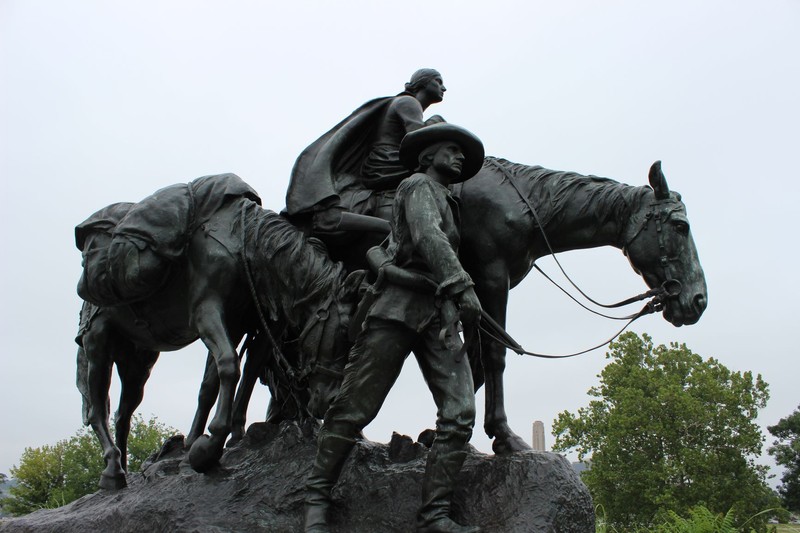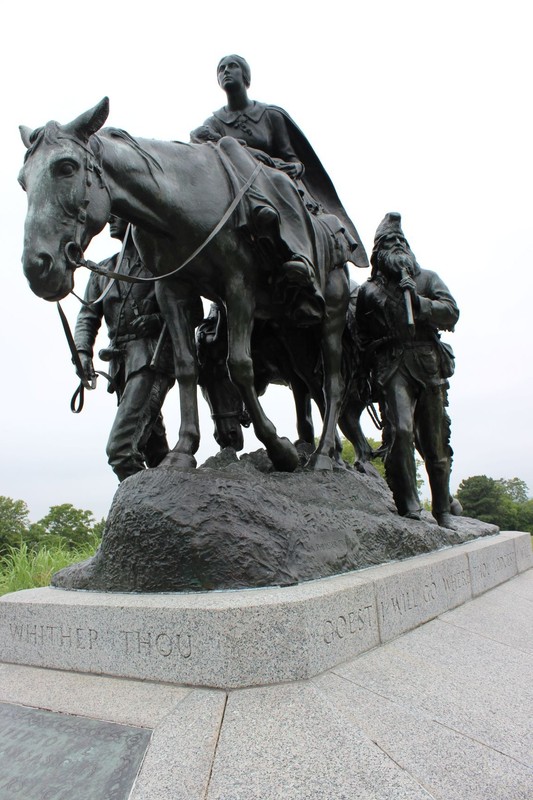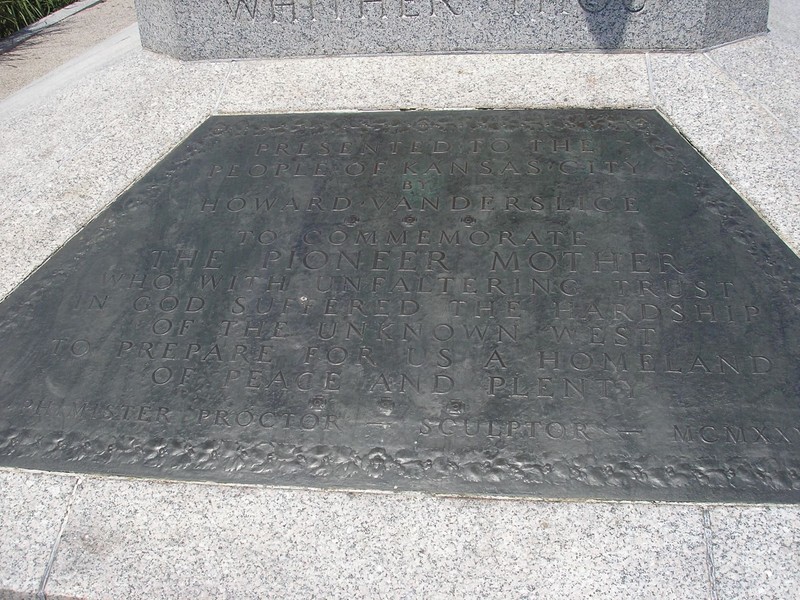Pioneer Mother statue (Kansas City, MO)
Introduction
Text-to-speech Audio
Images
A. Phimister Proctor, "Pioneer Mother," 1927. Photo by Cynthia Prescott

A. Phimister Proctor, "Pioneer Mother," 1927. Photo by Cynthia Prescott

Dedication plaque. Photo by Cynthia Prescott

Backstory and Context
Text-to-speech Audio
Prominent western American artist Alexander Phimister
Proctor sculpted this larger-than-life bronze grouping. It was one of the
most prominent works of the Pioneer Mother Movement (1925-1940). But public
interest in the statue soon waned. Today, it is largely ignored by Kansas City
residents. Yet the city refuses to give the statue to the village of Westport, which claims to be Kansas City's birthplace.
For many years, Phimister Proctor wanted to create a monument to female pioneers. That desire remained unformed until 1922, when he viewed WHD Koerner’s Madonna of the Prairie. Koerner’s instantly popular illustration portrayed the beautiful young heroine of Emerson Hough’s popular novel The Covered Wagon seated on a wagon box with the opening of the wagon cover forming a halo around her face. Like Koerner, Proctor was determined not to show a pioneer woman “plodding westward in a calico dress,” as many pioneer monuments of that era did. Instead, Proctor depicted “another, no less heroic side."1 Proctor placed his Prairie Madonna on horseback. She rides side-saddle with her baby in her lap and her sunbonnet hanging down her back. Her buckskin-clad husband, a grizzled mountain man guide, and a pack mule accompany her.
Proctor drew on ancient scripture, Renaissance imagery, mid-19th-century painting, and early 20th-century illustration in his sculpture. Proctor adapted maternal imagery from George Caleb Bingham’s famous 1851 painting Daniel Boone Escorting Settlers Through the Cumberland Gap. Bingham’s famous painting used the Renaissance image of Mary and Joseph’s flight to Egypt to show American westward migration. The painter placed the Madonna on horseback at the top of the grouping’s triangular shape. Proctor adapted this pyramidal structure in his sculpture. By so doing, Proctor likened Pioneer Mothers to the Virgin Mary. This emphasized the Pioneer Mother’s role in bringing white civilization to supposedly savage Indian lands. To show his Prairie Madonna’s self-sacrifice in migrating westward, Proctor encircled his larger-than-life bronze grouping with a text from the Book of Ruth: “Whither thou goest I will go. Thy people shall be my people and thy God my God.” Despite these varied cultural influences, Proctor was convinced that his monument authentically depicted the spirit of frontier women who followed their pioneer husbands westward.
Phimister Proctor prided himself on the authenticity of his western-themed sculptures. Like other leading western artists like Frederic Remington and Charles M. Russell, Proctor clung to a fantasy of authenticity. Yet their work was heavily influenced by mythology and historical memory. For example, to work on the Kansas City Pioneer Mother, Proctor moved his family from Palo Alto to southern California. Proctor he was “[c]ertain that western characters would be easier to find in Hollywood than anywhere else”2—even though authentic frontier conditions persisted in the northern Great Plains at the time. In Hollywood, Proctor soon selected “an old bewhiskered gentleman” to pose for the westering family’s trapper guide who had recently completed work as a body double for Ernest Torrence in the film adaptation of The Covered Wagon. Similarly, the young woman Proctor chose to represent the pioneer mother in the Kansas City monument wore a costume of questionable historical accuracy sewn by the artist’s wife. The model sat on a side-saddle given to the artist by a woman who claimed--rather unconvincingly--to have ridden across the Plains on it as a bride in 1852.
Kansas City businessman Howard Vanderslice sought to honor his own mother and other pioneers by commissioning the pioneer woman memorial that Proctor envisioned. The $250,000 cost ($3.4 million in 2015 dollars) was so exorbitant that Vanderslice kept it out of the newspapers.
The nearby village of Westport claimed to having birthed Kansas City. Westport residents believed that Proctor’s statue belonged in their community, instead. Westport business leaders and the Daughters of Old Westport urged Kansas City’s Park Board to place the massive sculptural group on a tiny trolley island at the heart of Westport’s business district that had been the site of their original town. They insisted that Westport site's location on the old Santa Fe Trail (which was built for commercial traffic to Hispanic New Mexico, rather than Yankee overland migration) made it the most suitable location for Proctor's sculpture of a westering Yankee family. In the end, though, the artist’s and donor’s preference for the statue to stand on a hilltop in Kansas City’s Penn Valley Park prevailed.
Newspaper coverage of the monument was extremely enthusiastic. Several local residents agreed that “’This is the only kind of statuary worth a d--n.”3 Nearly 30,000 reportedly attended its 1927 dedication. Like Pioneer Mother monuments in other western cities, though, interest in the statue quickly waned.
By the 1980s, residents and city leaders had chosen to forget the statue that glorified westward expansion and depicted women as meekly submitting to their husbands. But Westport merchants once again sought to claim Proctor’s statue for their business district. Advertiser Tom Tupper declared that the “gigantic statue” was only viewed “by about 16 people a year--if they can find it.”4 Instead, the Westport businessmen proposed to move it to Heritage Park to commemorate Westport’s 150th anniversary. They argued it would also commemorate a Westport resident and civic volunteer who was among the 114 killed when the skywalk of Kansas City’s Hyatt Regency hotel collapsed near Proctor’s Pioneer Mother monument in 1981. Tupper suggested that private donations to that victim’s memorial fund should cover the estimated $50,000 cost to move the statue. Westport’s business and political leaders endorsed the plan. But the Kansas City Parks and Recreation Board of Commissioners voted unanimously to leave the statue where Proctor had placed it a half-century earlier, overlooking downtown Kansas City.
The Kansas City park board was determined to keep the statue, but not to maintain it. By 2007, the Kansas City Star decried the “embarrassing weedy mess” that surrounded the “icon of KC's frontier past,” opining that it “should be a place for peaceful contemplation and beauty.”5 Tellingly, city officials only discovered the neglect of the statue while surveying potential light-rail routes through the park. Local residents who visit the park regularly remain unaware of its existence.
Sources
1 Quoted in Hassrick, Peter H. Wildlife and Western Heroes: Alexander Phimister Proctor, Sculptor. Amon Carter Museum, 2003. 211.
2 Proctor, Alexander Phimister. Sculptor in Buckskin: The Autobiography of Alexander Phimister Proctor. University of Oklahoma Press, 2009. 193.
3 “As Those of Their Blood: Kansas Citians View the ‘Pioneer Mother’ and Reminisce,” Kansas City Star, November 13, 1927.
4 “Will Pioneers Find a Home in Westport?,” Kansas City Star, January 12, 1983.
5 “Neglect surrounds an icon of KC’s frontier past,” The Kansas City Star, July 22, 2007, B8.
Proctor, Alexander Phimister. Sculptor in Buckskin: The Autobiography of Alexander Phimister Proctor. University of Oklahoma Press, 2009.
Kansas City Parks, Recreation Department. Microfilm PA-78. Kansas City Parks, Recreation Department Archives, Kansas City, Missouri.
"Statues--Pioneer Mother." Vertical File. Missouri Valley Room, Kansas City Public Library.Hassrick, Peter H. Wildlife and Western Heroes: Alexander Phimister Proctor, Sculptor. Amon Carter Museum, 2003.
Prescott, Cynthia Culver. Pioneer Mother Monuments: Constructing Cultural Memory. Norman, Oklahoma. University of Oklahoma Press, 2019.
